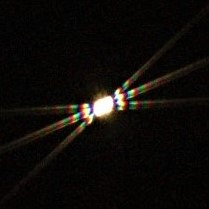The Bahtinov Mask, invented in 2005 by a Russian amateur astronomer, Pavel Bahtinov in 2005, is a device used to focus using a bright star. There are many methods, software and devices on the market but the Bahtinov Mask is the least expensive and is a very effective tool. It can be used alone or in conjunction with software such as APT Tool, BYE for greater focusing precision.
The Bahtinov Mask is fitted to the front of the telescope (camera if used alone). A star of at least 4 magnitudes should be chosen. If a camera is used alone or in conjunction with a telescope the ISO can temporarily be increased so that the star is better seen on Live View. Software can be handy (because the screen on a camera is small) and additional focusing aids for the Bahinov Mask are available. In addtion a view that shows a 1:1 ratio (such as 5x mag with Canon EOS 70D) will give a more precise focus result.
The Bahtinov Mask grating produces a diffraction pattern consisting of 3 spikes. The goal is to center the the middle spike between the outer two spikes using the fine adjustment of the telescope or camera if used alone. The mask is removed after focusing is achieved. It is better to focus on a bright star in the near vicinity and elevation in the sky where you intend to do your imaging. The reason for this is that atmospheric turbulance, dust and other factors vary with elevation and will affect the position of precise focus and hence viewing and imaging.
…Other Methods of Focusing:
Focusing on a bright star using the aid of the Live View Finder of a camera and zoomed even at 10x is of limited value because of the small size of the window. Better still is to use a software program that can zoom in on the star, such as Astrophotography Tool, BackYard EOS, Firecapture or Sharpcap to name a few… where the image is large enough to easily be manipulated by the telescope focuser…I found that this was a speedy method and served my needs. In addition these programs have precise focusing based on the principle of a star’s FWHM value. When FWHM is at its lowest value, accurate focus has been achieved.
An important point to make here is that a more accurate focus will be achieved if a star is chosen near the vicinity of the intended imaging. The reason is that due to variations in dust and other atmospheric factors the level of focusing will vary in different regions of the sky.

